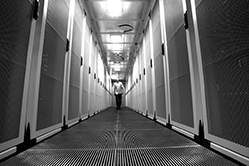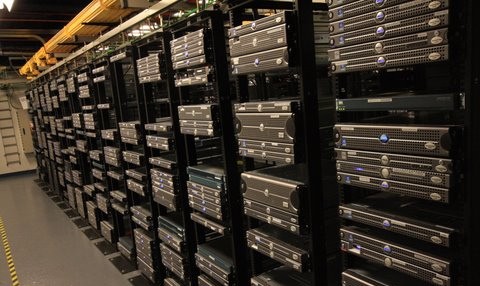Blog posts tagged data centre
Should you move to a data centre?
 Your business needs to maintain a reliable backup of digital data, like your customer database, documents, images, emails, accounts and so on.
Your business needs to maintain a reliable backup of digital data, like your customer database, documents, images, emails, accounts and so on.
That data is mission critical, so it all has to be kept safe from theft, fire, flood or accidental deletion. If you run a smaller company, it’s likely your data is stored on a simple server in the office.
What happens as your business grows?
As demand grows for your company’s products or services, you’ll collect more data. As a result, you inevitably end up needing more than a single server. Eventually, you end up with a whole room of the things. This brings new demands and costs:
- You need air conditioning, because lots of servers create lots of heat. If you don’t keep them cool they can fail catastrophically. Providing cooling using traditional air-conditioning units can be very expensive.
- You need an IT professional to make sure your servers keep running reliably. For 24/7 cover you’ll probably need more than one person.
These requirements can become a major financial, logistical and security headache.
Moving to a data centre
A common solution to these problems is to use a purpose-built data centre. Maintained by network specialists, mechanical experts and electrical engineers, a data centre is a secure, computer-friendly environment run at the perfect temperature for the servers inside.
From a security perspective, data centres are also equipped with their own backup power supply. This is usually an uninterruptable power supply (UPS), a large bank of batteries plus a generator to ensure power is always available.
Data centres also usually have direct connections into major internet links – also called the ‘internet backbone’ – meaning connectivity is fast and reliable.
Businesses usually put their servers into a data centre that’s shared with other organisations. This is known as colocation.
What does a data centre look like?
The image above is of a typical data centre. They have lots of aisles between servers stacked in locked cabinets (called racks). You rent as many racks as you want and you pay according to the amount of processing power, storage space or bandwidth you use.
Many providers off both DIY and full service maintenance options, so you can maintain systems yourself or use the provider’s technical support.
There are a number of good arguments for using a data centre:
- Data can be backed up easily and securely
- The risk of data loss is significantly reduced
- Internet access is fast and reliable
- The data centre provides support round-the-clock
- Your overheads are reduced
Using a data centre also makes it easy to add extra capacity as your business grows (you just rent more space) and you don’t have to worry about having lots of servers on your premises.
- Is IT the fifth utility?
- Can the cloud make you more efficient?
- Six signs your business needs a server
David Barker is technical director and founder of 4D Data Centres, the green colocation and connectivity supplier.
If Amazon can't make the cloud work, can anyone?

Inside a data centre. Photo from Neospire on Flickr under Creative Commons.
You might have read about problems last month with Amazon’s web hosting service. These affected many well-known websites, including Q&A social network Quora, Foursquare and Reddit.
The outage sparked some debate about how far businesses can rely on cloud services, especially if they’re unable or unwilling to commit to services offering a high level of security and backup.
Don’t let Amazon cloud your decisions
’The cloud’ has been billed as the be all and end all, but like any other business-critical service, you can only count on it if it’s backed up by solid business continuity planning.
Reading between the lines, the Amazon customers least affected by the outage were those with budgets big enough to afford the company’s premium service. They get the peace of mind of knowing that their data’s stored in more than one location.
However, many start-ups and small businesses use cloud services in order to benefit from low up-front costs and manageable ‘pay as you go’ charging. For some, this means they invest in a bottom dollar package from a mass market provider.
But if you don’t choose wisely, taking this route can end up compromising business continuity. What’s more, you may eliminate one of the main reasons for taking the cloud computing route in the first place: complete assurance that your data and systems are protected in every eventuality.
Multiple locations matter
If your chosen cloud computing supplier can only offer hosting from a single location – also called a ‘data centre’ - within your budget allowance, it’s usually worth shopping around. A niche provider that caters specifically for smaller businesses like yours may understand and meet your requirements more effectively.
The key thing is the number of places where your data is stored. Without at least two data centres, you leave yourself at higher risk of service interruptions and failures. Having all your applications and data stored at one site may be no safer than sticking your server in the corner of the office.
True, cloud services have expert engineers available to fix problems quickly, but if your data’s hosted in at least two separate locations it is highly unlikely that both environments will be affected at the same time. So if there’s a problem, you can keep working as normal.
Do remote networks right
My message to companies out there that are questioning cloud technologies after the Amazon outage is to take heed: remote networks are more secure than many traditional systems and, moreover, easier to reinstall should onsite disaster strike.
However, this only applies if you’ve got the right provisions in place. Make sure your cloud provider has more than one data centre, and examine their business continuity plans in detail.
Adrian Smith is MD of Heywood-based IT services provider Flexsys.



